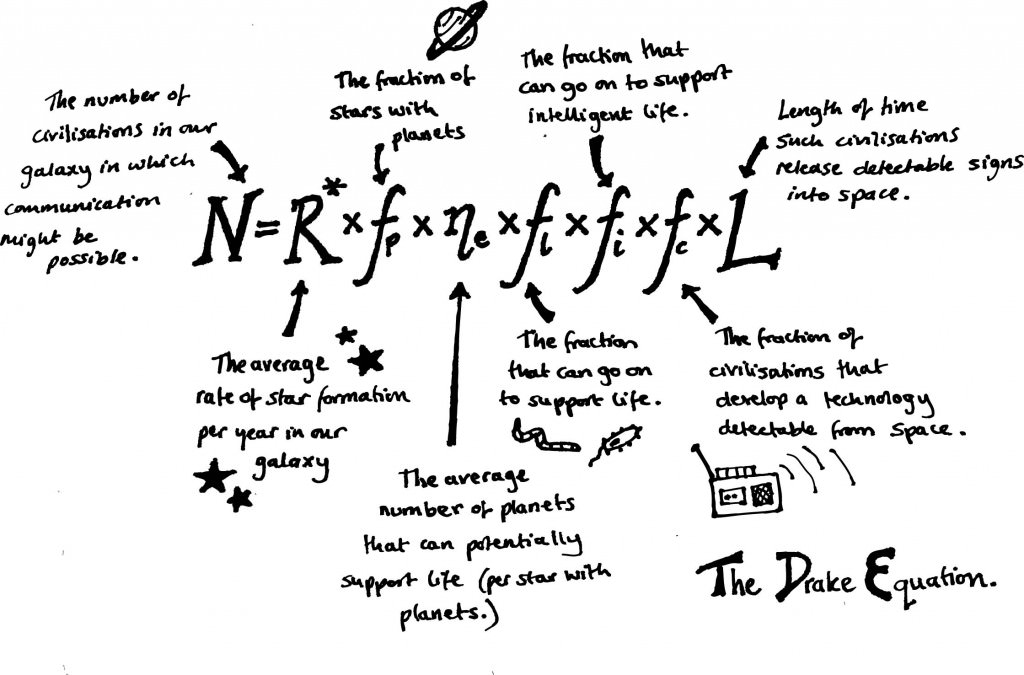Legendary astronomer Frank Drake has passed away at the age of 92. Known primarily for his Drake Equation — an estimate of the probability of intelligent extraterrestrial life — he pioneered the field of SETI, the Search for Extraterrestrial Intelligence, and was a noted astronomer and astrophysicist. His work and life have left an indelible mark on humanity and given hope and wonder to all our hearts.
 Drake Equation (image credit: Colin A Houghton)
Drake Equation (image credit: Colin A Houghton)I remember the first time I saw the Drake Equation. It was a revelation. While all the different variables can be perplexing at first glance, to me it gave order to an unordered cosmos: the idea that we could actually – one day – plug genuine numbers into the equation meant we don’t have to be haphazard in thinking about the possibility life elsewhere.
While the Drake Equation is more of a thought experiment, it gives us an outline or framework for seriously considering other life in the cosmos. And it gives us all hope that one day we can actually plug in some definite numbers to all the variables. SETI Institute’s Jill Tarter has called the equation “a great way to organize our ignorance.”
When radio stations started broadcasting in the 1920’s, it didn’t take for scientists long to realize radio waves were disseminating our radio –and later — TV transmissions out into space at the speed of light, potentially traveling long distances across the galaxy. They also wondered if the reverse were true: if another civilization from a faraway world was also creating similar transmissions, could we hear them?
 Frank Drake writing his famous equation on a white board. Credit: SETI.org
Frank Drake writing his famous equation on a white board. Credit: SETI.orgIn 1959, Drake came up with the idea for what would eventually become SETI, and designed an experiment to detect signals from intelligent life on planets that might be orbiting two nearby sunlike stars, Tau Ceti and Epsilon Eridani. He named the experiment Project Ozma, and for three months, he aimed the Green Bank Observatory’s Tatel Telescope at those two stars. This was before we knew for certain that other stars hosted planets, and nearly a half century later planets were discovered orbiting both those stars.
Drake’s experiment didn’t detect any transmissions, but Project Ozma attracted so much attention that in 1961, the National Academy of Sciences asked Drake to hold a meeting at Green Bank to discuss how a scientific search for extraterrestrial intelligence could be organized. He came up with his equation as a “conversation starter” for the meeting.
While so far, the search has come up empty, we now can plug in at least one of the numbers: the fraction of stars with planets in our galaxy. Because of the Kepler planet hunting mission, we know that that almost all stars have planets, and there could be as many as 300 million Earth-sized rocky worlds in the Milky Way that orbit sunlike stars.
But, there’s another way to look at the this equation. Drake’s daughter Nadia Drake is a noted space and science journalist. Last year she wrote, ”If anything, the Drake Equation’s most enduring legacy is not a numerical solution, but a mirror: It asks us to think about Earth, and about humankind, from a cosmic perspective—to consider the fragility of our existence in this galactic sea.”
You can read the Drake’s family’s thoughts on Nadia’s website.
SETI Institute’s remembrance of Frank Drake

